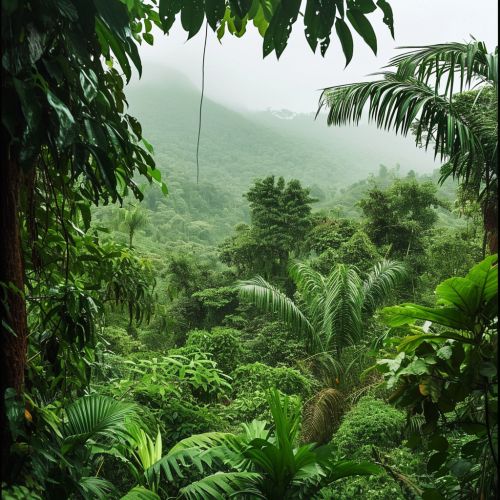Biodiversity in Colombia
Overview
Colombia, located in the northwestern part of South America, is recognized as one of the world's "megadiverse" countries, hosting close to 10% of the planet's biodiversity. Due to its geographical location, varied topography, and wide range of climates, Colombia is home to an impressive array of species, many of which are endemic to the country. This article explores the rich biodiversity in Colombia, focusing on its flora, fauna, and the ecosystems that sustain them.

Flora
Colombia's flora is diverse and abundant, with over 130,000 plant species, including a large number of endemic species. The country's diverse ecosystems, ranging from the tropical rainforests of the Amazon to the high-altitude Andean páramos, provide a unique habitat for a wide variety of plant species.
Tropical Rainforest Flora
The Amazon rainforest, which covers a significant portion of Colombia's territory, is home to an estimated 40,000 plant species. This includes a large number of tree species, with Colombia having one of the highest tree diversity in the world. Among these are the rubber tree (Hevea brasiliensis), the kapok tree (Ceiba pentandra), and the giant water lily (Victoria amazonica).
Andean Flora
The Andean region of Colombia, characterized by its high-altitude páramos, is home to a unique and diverse flora. The páramos ecosystem is one of the most important in the world for water regulation and is home to a large number of endemic plant species. Among the most notable are the frailejones (Espeletia spp.), a group of plants adapted to the harsh conditions of the páramos.
Fauna
Colombia's fauna is equally diverse, with the country hosting the highest number of bird species in the world. The country's diverse ecosystems provide habitats for a wide range of animal species, from the Amazon rainforest to the Andean highlands.
Amazon Rainforest Fauna
The Amazon rainforest in Colombia is home to a diverse range of animal species. This includes a large number of mammal species, such as the jaguar (Panthera onca), the giant anteater (Myrmecophaga tridactyla), and the Amazon river dolphin (Inia geoffrensis). The Amazon is also home to a vast array of bird species, including the harpy eagle (Harpia harpyja) and the hoatzin (Opisthocomus hoazin).
Andean Fauna
The Andean region of Colombia is home to a diverse range of animal species, many of which are adapted to the high-altitude conditions. Among the most notable are the Andean condor (Vultur gryphus), the spectacled bear (Tremarctos ornatus), and the Andean cock-of-the-rock (Rupicola peruvianus).
Ecosystems
Colombia's biodiversity is supported by its diverse ecosystems, which range from the tropical rainforests of the Amazon to the high-altitude páramos of the Andes.
Amazon Rainforest
The Amazon rainforest, the largest tropical rainforest in the world, covers a significant portion of Colombia's territory. This ecosystem is characterized by its high biodiversity, with a large number of plant and animal species.
Andean Páramos
The Andean páramos are a unique high-altitude ecosystem found in Colombia. Characterized by its harsh conditions, the páramos are home to a unique flora and fauna, many of which are endemic to this ecosystem.
Conservation
Despite its rich biodiversity, Colombia faces significant challenges in terms of conservation. Deforestation, illegal wildlife trade, and climate change are among the main threats to Colombia's biodiversity. The Colombian government, along with various non-governmental organizations, is working on various conservation initiatives to protect the country's biodiversity.
